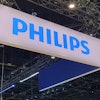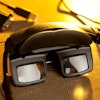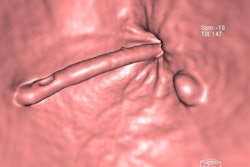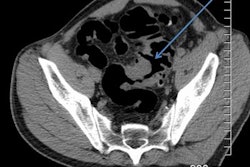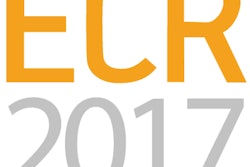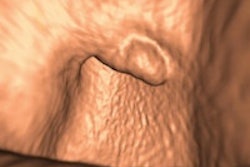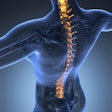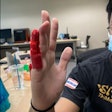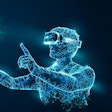
A new kind of electronic-cleansing algorithm can deliver reduced-prep CT colonography (CTC) to routine clinical practice, according to results from a multinational team of researchers. The group's technique for CTC outperformed two conventional methods, producing far fewer artifacts that have traditionally complicated efforts to create an easier colon cancer screening exam.
The study from two Japanese universities as well as Massachusetts General Hospital in Boston and Harvard University in Cambridge, Massachusetts, U.S., along with the Institute for Cancer Research and Treatment in Candiolo, Italy, included 32 patients who underwent CTC (or virtual colonoscopy) with a reduced cathartic prep after scanning with ultralow-dose dual-energy CT.
 Dr. Junko Ota from Osaka University.
Dr. Junko Ota from Osaka University.The study compared a deep-learning machine-learning based electronic cleansing algorithm (DL-EC) with a standard machine-learning method (k-nearest neighbors, kNN) and a random-forest classifier (RF) technique in a search for electronic cleansing artifacts in areas where they typically appear. The DL method outperformed both other methods by delivering images that were accurate and nearly artifact-free.
"Deep-learning EC had significantly higher EC performance than the reference methods," said Dr. Junko Ota from Japan's Osaka University in her presentation at RSNA 2016. The study aimed to find a better method for electronic cleansing that could virtually remove the colonic contents that have been tagged with iodinated contrast to enable visualization of the colonic mucosa underneath -- but without the troublesome electronic cleansing artifacts.
Artifacts everywhere
"Noncathartic CTC can increase compliance with screening guidelines because the risk and inconvenience of colorectal cancer screening is reduced," she said. In noncathartic CTC, patients drink diluted contrast agent which opacifies fluid and feces, enabling the colon contents to be differentiated reliably from polyps in imaging. "However, electronic cleansing with current methods produces artifacts that can eliminate polyps or distort colon anatomy," Ota added.
Electronic cleansing produces three types of common artifacts, according to the presenter. First, boundaries between air and tagging that indicate soft tissue can incorrectly remain in electronically cleansed images (Type 1). Second, thin layers of soft tissue between air and tagging can be incorrectly removed by the EC algorithm (Type II); and finally, three-material mixtures of air, soft tissue, and tagging can be rendered incorrectly in the EC image (Type III). Could an automated technique based on machine learning eliminate or significantly reduce them?
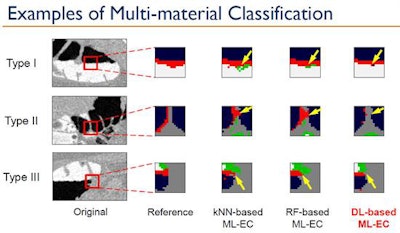 Multimaterial classification compares the ability of three machine learning techniques to correctly label colonic regions for CT colonography: k-nearest neighbor-based electronic cleansing, random forest classifier electronic cleansing (RF), and deep learning based electronic cleansing (DL-EC), also known as deep convolutional neural network (DNNC)-base electronic cleaning. All images courtesy of Dr. Hiroyuki Yoshida, PhD, Harvard School of Medicine.
Multimaterial classification compares the ability of three machine learning techniques to correctly label colonic regions for CT colonography: k-nearest neighbor-based electronic cleansing, random forest classifier electronic cleansing (RF), and deep learning based electronic cleansing (DL-EC), also known as deep convolutional neural network (DNNC)-base electronic cleaning. All images courtesy of Dr. Hiroyuki Yoshida, PhD, Harvard School of Medicine."The purpose of this study was to develop an automated learning scheme for electronic cleansing in noncathartic CT colonography," Ota said. The novel deep-learning method would be used in ultralow-dose dual-energy CT colonography, and its performance compared with conventional kNN-based and random-forest-based machine learning electronic cleansing methods in producing the correct electronic cleansing results.
Problem areas analyzed
The DL-EC method works by first calculating two material decomposition images highlighting water (w) and iodine (i) from the low-dose DECT images, she explained. From these, two virtual monochromatic images are created and used as input for the machine-learning algorithm kNN, random forest (RF), and DL.
Machine learning was used to label the images into regions of lumen air, soft tissue, fecal tagging, and two different types of patient-volume boundaries based on the features of these images. Finally, electronic cleansing was performed by removing materials other than soft tissue from the original CTC images.
A multimaterial labeling function (MUMA) then divided the materials into five classes using deconvolution neural networks (DCNN): luminal air, tagging material, soft tissue, partial volume between air and tagging, and partial-volume boundary between soft tissues and tagging in the axial, coronal, and sagittal planes, Ota said.
The study included 32 patients who had been prepped for CT colonography exams. All were given 50 mL of oral contrast agent (Gastrografin) one day before and prior to the exam. Dual-energy CT exams (Somatom Definition FLASH, Siemens Healthineers) were acquired at ultralow-doses using 140 kVp and 80 kVp and slice thicknesses of 1 mm at 0.60 mGy per scan position. Images were then reconstructed using Sinogram-Affirmed Iterative Reconstruction (SAFIRE, Siemens Healthineers).
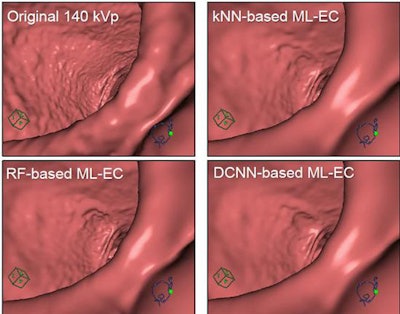 Three-dimensional visualization of colonic region using three electronic cleansing techniques and the reference standard shows that deep learning based electronic cleansing (DL-EC), also known as deep convolutional neural network (DNNC)-base electronic cleaning, does a better job of removing image artifacts.
Three-dimensional visualization of colonic region using three electronic cleansing techniques and the reference standard shows that deep learning based electronic cleansing (DL-EC), also known as deep convolutional neural network (DNNC)-base electronic cleaning, does a better job of removing image artifacts.In all, the evaluation analyzed 384 volumes of interest (VOIs) where current electronic cleansing schemes typically generate artifacts (Type I: air-tagging boundary; Type II: three-material layer; Type III: three-material mixture), extracting and labeling the volumes into a reference standard. They evaluated the EC accuracy using a mean overlap ratio (OR) between the reference standard labels and the labels generated by the ML-EC schemes.
A paired t-test with Bonferroni correction showed that the overlap ratio was significantly higher in deep-learning -- DL-based electronic cleaning versus kNN and RF-based machine learning electronic cleaning (p < 0.01 for both) in all three artifact types.
"Deep-learning EC had significantly higher EC performance than the kNN-based EC for all types of artifacts," Ota said, noting the deep learning-based EC also had significantly higher performance than the random-forest EC for Type II and Type III artifacts. "Deep-learning EC has potential to facilitate an effective noncathartic CTC screening examination for prevention of colorectal cancer."
